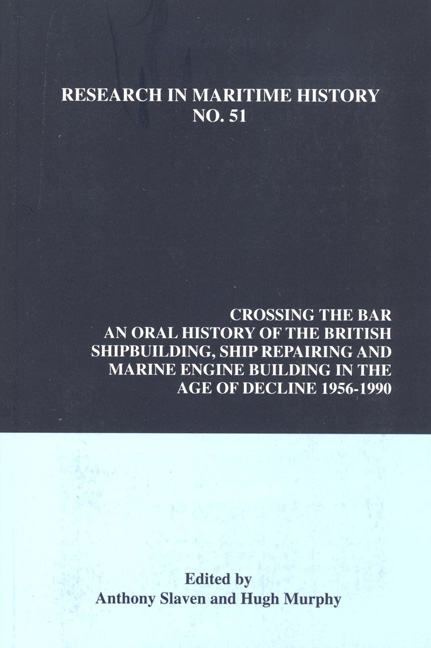 Crossing the Bar
Crossing the Bar from British Shipbuilding Industry Officials
I graduated in naval architecture in 1952, and then worked in various design consultancies until 1964 when I joined BSRA with the brief to build up and lead a team designing standard ships for the then private shipbuilding industry, by voluntary co-operation among the companies. In 1969 I started a new division within BSRA called the Marine Systems Division. On nationalisation I was invited by the Chairman, Admiral Griffin to join British Shipbuilders to be responsible for the Headquarters Research Group. By October 1981, I became Production and Systems Advisor to the small ships sector within British Shipbuilders.
My first exercise on joining BSRA was on designing standard bulk carriers; the project was steered by a committee of fourteen managing directors of British shipyards chaired by Jim Lenaghan of Fairfield. We were beginning to feel the impact of Japanese competition. There was a widespread belief in the committee that the Japanese were cheating by the under-provision of materials in their ships. I already had experience of Japanese bulk carrier design and construction, and was able to produce evidence that on the contrary they were putting more in. They were rationalising the variety of scantlings on steel work and thus making it easier. When I started the Marine Systems Division at BSRA the concept involved marine engineering and marine transport systems. The idea was to take a systems approach to things. There was a terrible confusion in people's minds which took years to eradicate that they could not see the difference between engineering systems and systems engineering. In a nutshell, what I was trying to do was to apply systems engineering approaches to engineering systems. That palindromic statement is the nub of the misunderstandings which took place.
We did undertake certain major exercises including one into advanced automation systems. A lot of that technology has not yet been implemented, especially in this country. It was based on the emerging electronic technology of the day. We also looked at advanced interactive computer aided design methods, focussing on ship structural design. The important thing was that we were too far ahead of the ability of the computing industry to support it. I went to British Shipbuilders, but after a year I stopped the project because the infrastructure technology from the computer industry was not there.
To save this book to your Kindle, first ensure [email protected] is added to your Approved Personal Document E-mail List under your Personal Document Settings on the Manage Your Content and Devices page of your Amazon account. Then enter the ‘name’ part of your Kindle email address below. Find out more about saving to your Kindle.
Note you can select to save to either the @free.kindle.com or @kindle.com variations. ‘@free.kindle.com’ emails are free but can only be saved to your device when it is connected to wi-fi. ‘@kindle.com’ emails can be delivered even when you are not connected to wi-fi, but note that service fees apply.
Find out more about the Kindle Personal Document Service.
To save content items to your account, please confirm that you agree to abide by our usage policies. If this is the first time you use this feature, you will be asked to authorise Cambridge Core to connect with your account. Find out more about saving content to Dropbox.
To save content items to your account, please confirm that you agree to abide by our usage policies. If this is the first time you use this feature, you will be asked to authorise Cambridge Core to connect with your account. Find out more about saving content to Google Drive.